|
|
|
Sort Order |
|
|
|
Items / Page
|
|
|
|
|
|
|
| Srl | Item |
| 1 |
ID:
119165
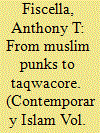

|
|
|
|
|
| Publication |
2012.
|
| Summary/Abstract |
This article is an attempt to provide a very rough outline of the historical interaction between punk rock and the Muslim world. For the most part, the antinomian youth culture of punk rock was relatively slow to reach Muslims outside of Europe and North America. When it did reach Muslim youth (from Europe to Asia to the Middle East), it tended to initially manifest in secular and antireligious terms. Yet by the 1990s, some examples of punk arose that claimed a Muslim identity, and by the year 2005, a scene called "taqwacore" developed. This new scene embraced both religious and nonreligious Muslim punks and others who did not self-identify as Muslim in any way. It's been called "punk Islam" and has made a place for itself on the fringes of the punk scene and the Muslim world. Finally, this article briefly addresses some ways in which taqwacore can be seen as a theological development within Islam.
|
|
|
|
|
|
|
|
|
|
|
|
|
|
|
|
| 2 |
ID:
119166
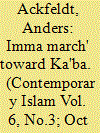

|
|
|
|
|
| Publication |
2012.
|
| Summary/Abstract |
The common history of Islam and the hip-hop culture can be traced back to the early expression of the culture. Since the early days of hip-hop, Muslims have used hip-hop to convey Islamic messages. Artists driven, in equal parts, by a strong personal belief in Islam and a love for hip-hop music have taken Islamic-themed hip-hop outside its country of birth, the U.S., and have made it into a matter of global concern. In an attempt to contribute to and, hopefully, complicate the picture of what has been called the transglobal hip-hop umma, this article explores how Swedish Muslims articulate their beliefs through hip-hop in Sweden. With examples from both the Swedish mainstream and the underground, it highlights hip-hop music with an Islamic engagement whose aim is to promote and perform what is understood as "Islamic values," such as ethics, peace, social responsibility, and a strong personal belief.
|
|
|
|
|
|
|
|
|
|
|
|
|
|
|
|
| 3 |
ID:
119162


|
|
|
| 4 |
ID:
119164
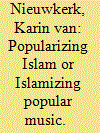

|
|
|
| 5 |
ID:
119168
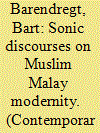

|
|
|
|
|
| Publication |
2012.
|
| Summary/Abstract |
Not only has Nasyid music been successful in addressing questions about what it is to be a modern Muslim youth in Southeast Asia, reconciling piety with a "funky but shariah" consumerist lifestyle; it also has been expressive of political aspirations for a utopian-style communal society. This essay focuses on how, from the late 1980s to the mid-1990s, the Malaysian missionary movement Al-Arqam used nasyid music to articulate ideas of Muslim Malay modernity and on how nasyid music became one of the main interfaces to spread the Arqam message beyond its model villages. The focus is on Arqam's main ensembles, Nadamurni and the Zikr, and, with the 1994 ban on Arqam's activities, the celebrated pop group Raihan. Raihan's sonic explorations into Muslim Malay modernity have challenged orthodox Islamic ideas, but also the entertainment industry and the secular Malaysian state at large. Nasyid culture provides us with an understanding of the larger changes that have occurred within Southeast Asian Islam, away from a previous Islamic revival and toward a post-Islamist chic and new cultural performances that successfully blend entertainment and education.
|
|
|
|
|
|
|
|
|
|
|
|
|
|
|
|
| 6 |
ID:
119167


|
|
|
|
|
| Publication |
2012.
|
| Summary/Abstract |
Hamas (Harakat al-Muqawamat al-Islamiyya) was established in 1987 as a resistance organization against Israel and as an alternative to Fatah. One of the resistance tools of Hamas is music, which it produces, performs, records, and uses. Music in the Palestinian context can be seen as creating a political space for expression that the Israelis cannot control; inasmuch as as Hamas was established as a result of the occupation, so also, to a large extent, was its music. Palestinian resistance music has existed ever since the 1948 al-nakba (the catastrophe), and music centers in Cairo and Beirut have been influential factors in its production. Originally, the music was constituted by a wide range of popular music, which included lyrics about the Palestinian struggle. This article scrutinizes how Hamas music is being created, how it is used, and how it is linked to the organization's resistance struggle against Israel and for a Palestinian homeland in the context of the Israeli-Palestinian conflict. It concludes that Hamas resistance music is not permeated by the religious affiliation of the organization. Rather, it has as its aim social connection, spreading the messages of the organization, and exhorting resistance against Israel. In addition to resistance music, Hamas produces and uses music of grief and tributes to political and religious leaders, as well as anashid, songs different from the resistance music saturated by a religious character.
|
|
|
|
|
|
|
|
|
|
|
|
|
|
|
|
| 7 |
ID:
119169
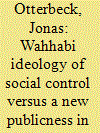

|
|
|
|
|
| Publication |
2012.
|
| Summary/Abstract |
To understand Saudi Arabian Wahhabi theology, it needs to be contextualized. This article explores the discussion about music in Saudi Arabia in order to illuminate the political theory of the social of Wahhabi theology and the ongoing transformation of Saudi publicness. Since Wahhabism has singled out music as one of the abominations of society to be avoided by the believer, the changing soundscapes of the kingdom as music becomes a more common public presence has becomes a hot topic of discussion. By looking at the common Wahhabi stand on music and comparing it with both new practices and a new discourse represented by the scholar al-Kalbani, it becomes clear how a plurality of opinions challenge established Wahhabi agendas in a new publicness. This, in its turn, makes it relevant to investigate the logic of the political vision of the social that the official Wahhabi scholars have. I argue that this Wahhabi theology needs to be understood in the framework of its view on the human psyche and in relation to its concept of sin. I further argue that a renegotiation of positions is taking place, since negative judgments about music are not internalized in the population to the extent scholars might wish for or envisage.
|
|
|
|
|
|
|
|
|
|
|
|
|
|
|
|
|
|
|
|
|